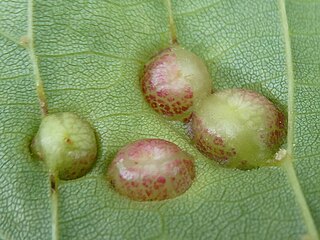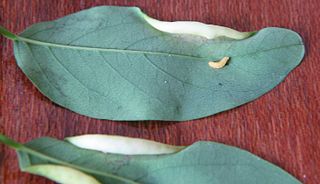
A midge is any small fly, including species in several families of non-mosquito nematoceran Diptera. Midges are found on practically every land area outside permanently arid deserts and the frigid zones. Some midges, such as many Phlebotominae and Simuliidae, are vectors of various diseases. Many others play useful roles as prey for insectivores, such as various frogs and swallows. Others are important as detritivores, and form part of various nutrient cycles. The habits of midges vary greatly from species to species, though within any particular family, midges commonly have similar ecological roles.

Aprostocetus is a genus of hymenopteran insects of the family Eulophidae. The genus was erected by John O. Westwood in 1833. This very large group of parasitoid wasps has a global distribution.

A gnat is any of many species of tiny flying insects in the dipterid suborder Nematocera, especially those in the families Mycetophilidae, Anisopodidae and Sciaridae. Most often they fly in large numbers, called clouds. "Gnat" is a loose descriptive category rather than a phylogenetic or other technical term, so there is no scientific consensus on what constitutes a gnat. Some entomologists consider only non-biting flies to be gnats. Certain universities and institutes also distinguish eye gnats: the Smithsonian Institution describes them as "non-biting flies, no bigger than a few grains of salt, ... attracted to fluids secreted by your eyes".

Contarinia verrucicola, known generally as the linden wart gall midge, is a species of gall midges in the family Cecidomyiidae.
Taxodiomyia taxodii, the cypress leaf gall midge, is a species of gall midges, insects in the family Cecidomyiidae.

Asphondylia is a cosmopolitan genus of gall midges in the family Cecidomyiidae. All species in this genus induce galls on plants, especially on flowers and flower buds. There are over 300 described species in Asphondylia, with many more likely to be discovered and described, especially in the southern hemisphere.

Asphondyliini is a tribe of gall midges in the family Cecidomyiidae. There are about six genera and at least 100 described species in Asphondyliini.

Caryomyia is a genus of hickory gall midges in the family Cecidomyiidae. They are often known as the hickory gall midges since most species feed on various species of hickory. There are at least 30 described species in Caryomyia.

Rhopalomyia is a genus of gall midges, insects in the family Cecidomyiidae. There are at least 267 described species in Rhopalomyia. Most species in this genus induce galls on plants in the Asteraceae. This genus has a cosmopolitan distribution. Rhopalomyia was first established by Ewald Heinrich Rübsaamen in 1892.
Neolasioptera is a genus of gall midges, insects in the family Cecidomyiidae. There are at least 130 described species in Neolasioptera.
Bremia is a genus of gall midges. There are at least 20 described species in Bremia.
Paradiplosis is a genus of gall midges, insects in the family Cecidomyiidae. There are at least four described species in Paradiplosis.
Thecodiplosis is a genus of gall midges, insects in the family Cecidomyiidae. There are about six described species in Thecodiplosis.
Pinyonia is a genus of gall midges, insects in the family Cecidomyiidae. There is at least one described species in Pinyonia, P. edulicola.

Obolodiplosis is a genus of gall midges. It is monotypic, being represented by the single species Obolodiplosis robiniae, commonly known as the locust gall midge.
Sackenomyia is a genus of gall midges, insects in the family Cecidomyiidae. There are about five described species in Sackenomyia.
Pilodiplosis is a genus of gall midges, insects in the family Cecidomyiidae. There is at least one described species in Pilodiplosis, P. helianthibulla.

Taxodiomyia cupressiananassa, commonly known as the cypress twig gall midge, is a species of gall midge in the family Cecidomyiidae.
Rabdophaga rosacea is a species of gall midge that creates rosette galls on roses found in the central plains of North America.










